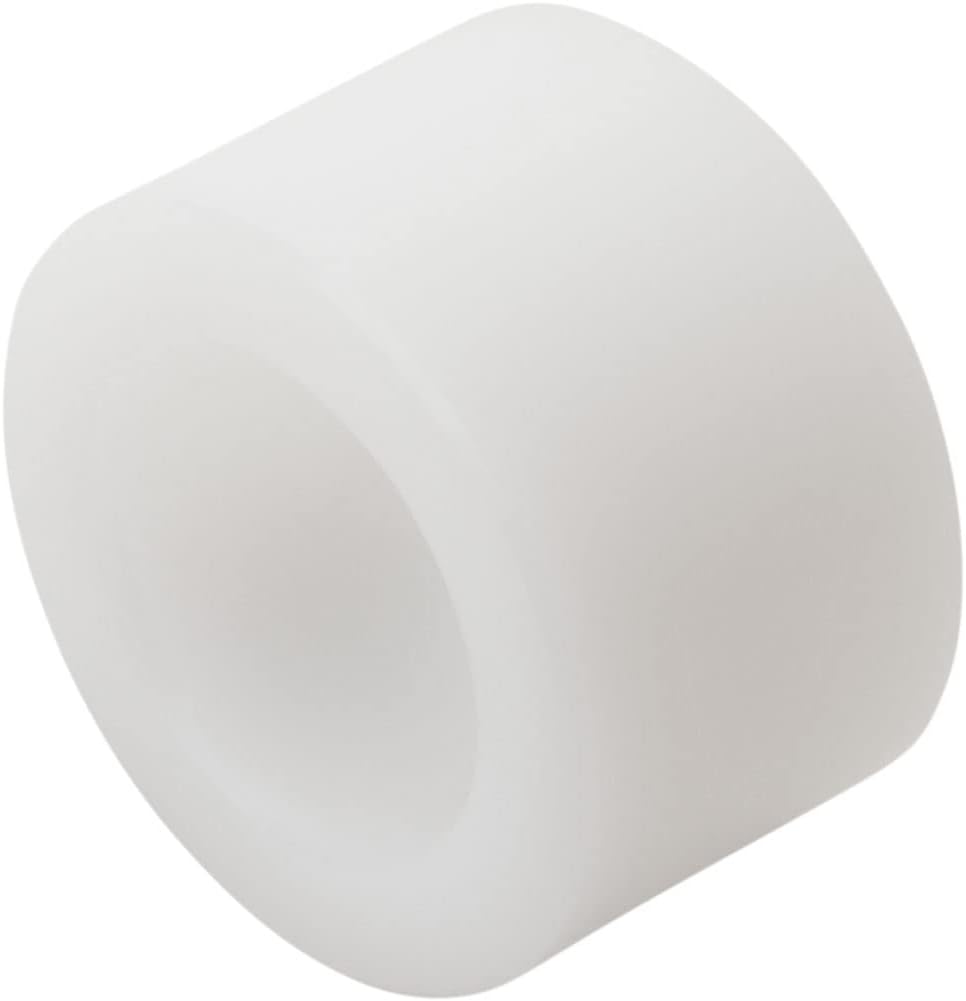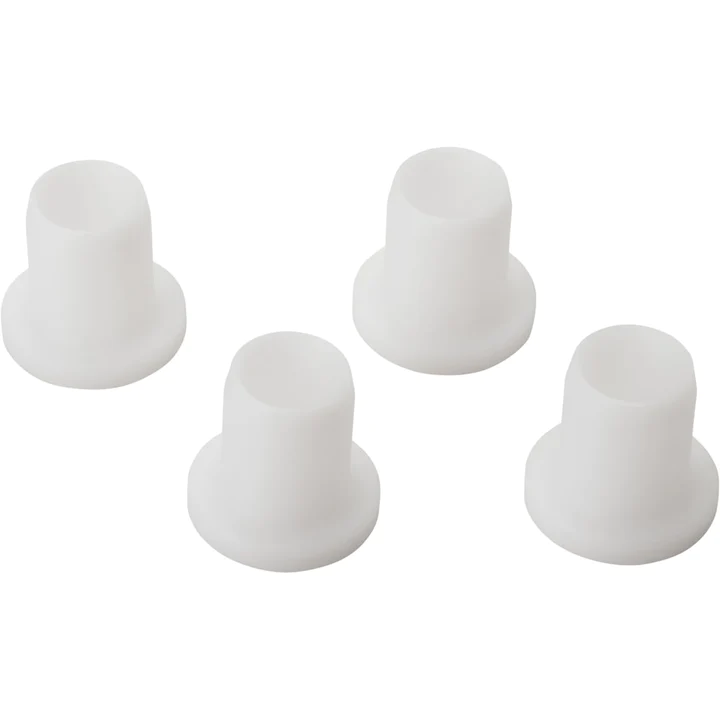Product Description
Plastics Uhmw-Pe bushing with wear resistance
UHMW-PE(Ultra high Molecular Weight Polyethylene )is a thermoplastic engineering plastic with the average molecular weight more than 9.0 million. (PE only has the molecular weight between 20 to 2 hundred thousand. ) This kind of material with 5 top performance of high-wear-resistance, good-chemical resistance, low-temperature resistance, self-lubrication and high-impact resistance, which is regarded as a “surprised” engineering plastic of excellent comprehensive capacity and competitive price.
Main characteristics:
1. Very high-wear resistance, 7 times wear resistance than steel, 4 times than PTFE
2. Very high anti-impact resistance, 2 times impact resistance than PC, 5 times than ABS.
3. Good self-lubrication, the same as PTFE, better than steel and brass appended lubricating oil.
4. Good anti-corrosion resistance, it has very stable chemicals property and can endure the corrosion of all kinds of corrosive medium and organic solvent in certain rang of temperature and humidity.
5. Very high-inadhesion resistance, the surface of product hardly affixes other material.
6. Very high-impact resistance, 10 times impact resistance than PA66, 8 times than PTFE.
7. Good low temperature resistance, in liquefied nitrogen (- 196º C), it still has the prolongation.
Few other materials can reach to this performance.
8. Non-toxic and clean property, UHMW-PE, which is the material that Food and Drug Administration (FDA) and United States Department of Agriculture (ASDA) permit to apply in food and medicine fields.
| Property | Item No. | Unit | Value | |
| Mechanical Properties | 1 | Density | g/cm3 | 0.94-0.96 |
| 2 | average molecular weight | g/mol | More than 9.0 million | |
| 3 | Tensile strength (23ºCin air) | MPa | 22 | |
| 4 | Breaking strength | MPa | 42 | |
| 5 | Tensile strain at break | % | 600 | |
| 6 | Charpy impact strength (notched) | mJ/mm 2 | No break | |
| 7 | Ball indentation hardness | N/mm 2 | 42 | |
| 8 | Shore D hardness | — | D65 | |
| 9 | Abrading(sand slurry experiment) | — | 100 | |
| Material: | PE |
|---|---|
| Size: | According to Drawing or Sample |
| Color: | White, Black, Green, Yellow, Blue, Red |
| Tooling: | CNC Lathe |
| Transport Package: | Packing in Paper Carton and Wooden Pallet |
| Specification: | RoHS, FDA |
| Customization: |
Available
| Customized Request |
|---|

Are there eco-friendly or sustainable options for UHMW bushing materials?
Yes, there are eco-friendly and sustainable options available for UHMW (Ultra-High Molecular Weight Polyethylene) bushing materials. Here’s a detailed explanation:
UHMW itself is a relatively environmentally friendly material compared to many other plastics. It is a thermoplastic polymer that can be recycled and has a long service life, which helps reduce waste. However, certain variations and manufacturing processes of UHMW can have different environmental impacts.
Recycled UHMW:
Recycled UHMW bushing materials are an eco-friendly option. They are made from post-consumer or post-industrial UHMW waste, reducing the need for virgin UHMW production and diverting plastic waste from landfills. Recycled UHMW retains many of the beneficial properties of virgin UHMW, making it suitable for various applications.
Bio-based UHMW:
Bio-based UHMW bushing materials are derived from renewable resources such as plant-based feedstocks. These materials offer a more sustainable alternative to traditional petroleum-based UHMW. Bio-based UHMW can help reduce dependence on fossil fuels and lower the carbon footprint associated with the production and use of UHMW.
Modified UHMW Formulations:
Modified UHMW formulations aim to improve the material’s sustainability by incorporating additives or fillers that enhance specific properties or reduce the overall environmental impact. For example, some formulations may include recycled content, bio-fillers, or additives that enhance biodegradability or compostability. These modifications can provide a greener option for UHMW bushings.
It’s important to note that the availability of eco-friendly or sustainable options for UHMW bushing materials may vary depending on the specific manufacturers and suppliers. When seeking such materials, it is advisable to look for certifications or labels that indicate their environmental attributes, such as recycled content certifications or bio-based certifications.
Additionally, manufacturers should consider the entire life cycle of UHMW bushings, from raw material extraction to disposal, to assess the overall environmental impact. This includes evaluating factors such as energy consumption, carbon emissions, waste generation, and end-of-life disposal options.
In summary, eco-friendly and sustainable options for UHMW bushing materials exist, including recycled UHMW, bio-based UHMW, and modified UHMW formulations. These alternatives help reduce waste, lower carbon footprint, and promote the use of renewable resources. By choosing these materials, manufacturers can contribute to a more environmentally conscious approach to UHMW bushing applications.

Are there potential challenges or limitations to using UHMW bushings?
While UHMW (Ultra-High Molecular Weight Polyethylene) bushings offer many advantages, there are also potential challenges and limitations to consider. Here’s a detailed explanation:
1. Temperature Limitations:
UHMW bushings have a relatively low melting point compared to other engineering plastics. They can soften or deform at elevated temperatures, typically around 82°C (180°F) or lower, depending on the specific grade and formulation. If your application involves high temperatures, alternative materials or additional heat-resistant measures may be necessary.
2. Wear and Abrasion:
While UHMW has excellent wear resistance, it may not be suitable for applications with extremely abrasive conditions or high levels of impact. In situations where there are aggressive abrasive particles or substantial mechanical forces, alternative materials or protective measures, such as incorporating additional bearing surfaces or coatings, may be required.
3. Load and Pressure Limitations:
UHMW bushings have a relatively low compressive strength compared to metals and some other engineering plastics. They may not be suitable for applications with high loads or pressure requirements. Exceeding the recommended load or pressure limits can lead to premature wear, deformation, or failure of the bushings. Consideration should be given to the specific load and pressure conditions of your application and alternative materials may need to be considered for heavy-duty applications.
4. Creep and Relaxation:
UHMW has a tendency to exhibit creep or relaxation under continuous or long-term mechanical stress. This means that over time, the material may slowly deform or experience dimensional changes. It is important to consider the duration and magnitude of the applied stress in relation to the specific UHMW grade being used and the desired performance criteria. In applications where dimensional stability is critical, periodic monitoring and potential adjustments or replacements may be necessary.
5. Chemical Compatibility:
While UHMW is chemically resistant to many substances, it may not be compatible with certain chemicals or solvents. It is important to consider the specific chemical environment in which the bushings will operate and verify the compatibility of UHMW with the substances involved. In cases where chemical resistance is a primary concern, alternative materials may need to be considered.
6. Dimensional Stability:
UHMW bushings can exhibit slight dimensional changes due to factors such as moisture absorption or temperature variations. While these changes are relatively small compared to some other materials, they should be taken into account in applications where precise tolerances or tight clearances are critical.
7. Machining and Fabrication:
Although UHMW is generally considered to be a machinable material, it can present challenges during machining due to its low thermal conductivity and high coefficient of thermal expansion. Proper tool selection, cutting parameters, and machining techniques specific to UHMW should be employed to achieve desired results. Working with experienced manufacturers or fabricators who are knowledgeable about UHMW machining is recommended.
In summary, while UHMW bushings offer numerous advantages, it is important to be aware of potential challenges and limitations related to temperature, wear and abrasion, load and pressure, creep and relaxation, chemical compatibility, dimensional stability, and machining. By carefully assessing these factors in relation to your specific application requirements, you can make informed decisions and potentially address these limitations through alternative materials, modifications, or protective measures.

How do UHMW bushings compare to other types of bearing materials?
When comparing UHMW (Ultra-High Molecular Weight Polyethylene) bushings to other types of bearing materials, several factors come into play. Here’s a detailed comparison:
1. Friction and Wear:
UHMW bushings have a low coefficient of friction, resulting in reduced friction and wear. Compared to materials like metal or bronze, UHMW bushings offer superior self-lubricating properties, which reduce the need for additional lubrication. This self-lubricating feature minimizes friction, wear, and the associated maintenance requirements.
2. Load Capacity:
UHMW bushings have excellent load-bearing capabilities, particularly under high-load conditions. They can distribute the load evenly, reducing stress concentrations and minimizing the risk of premature wear or failure. However, certain metals like bronze or steel may have higher load capacities in specific applications.
3. Wear Resistance:
UHMW bushings exhibit excellent wear resistance, making them suitable for applications involving repetitive sliding or rubbing motions. They can withstand continuous use without experiencing significant wear. Materials such as bronze or steel may also offer good wear resistance, but UHMW bushings often outperform them in applications requiring low friction and self-lubrication.
4. Chemical Resistance:
UHMW bushings have high resistance to a wide range of chemicals, acids, solvents, and corrosive substances. This chemical resistance protects the bushings from degradation, making them ideal for applications in harsh environments. In comparison, metals like steel or bronze may be susceptible to corrosion or chemical attack.
5. Impact Strength:
UHMW bushings have excellent impact strength, allowing them to withstand high loads and absorb shocks effectively. They can handle heavy-duty applications and resist deformation or failure even under significant impact forces. Other materials like bronze or steel may have varying levels of impact strength depending on their composition.
6. Temperature Resistance:
UHMW bushings have good temperature resistance, maintaining their properties over a wide temperature range. They can withstand both low and high temperatures without significant dimensional changes or loss of performance. In contrast, certain metals may have higher temperature tolerances but may exhibit thermal expansion or contraction.
7. Machinability:
UHMW bushings are relatively easy to machine, allowing for the creation of bushings with precise dimensions and tolerances. However, metals like bronze or steel can offer greater machining versatility and precision due to their inherent properties.
8. Cost:
UHMW bushings are generally cost-effective compared to many other bearing materials. They offer a long service life, reduced maintenance requirements, and resistance to wear and tear, contributing to overall cost savings. Metals like bronze or steel may have higher upfront costs but can be more economical in certain high-load or extreme temperature applications.
It’s important to note that the suitability of a bearing material depends on the specific application requirements. Factors such as load magnitude, speed, temperature, environment, and lubrication conditions should be considered when selecting the most appropriate bearing material.
In summary, UHMW bushings offer advantages in terms of low friction, self-lubrication, wear resistance, chemical resistance, impact strength, and cost-effectiveness. However, other materials like metals (e.g., bronze or steel) may excel in certain areas such as load capacity, temperature tolerance, or precision machining. Ultimately, the choice of bearing material should be based on a thorough evaluation of the application’s needs and the specific properties offered by each material.


editor by CX 2023-11-29